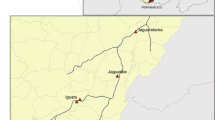Abstract
A number of natural and man-made habitats in Marigat area of Kenya were surveyed for sandflies in 1985/86. Of the 98,573 adult sandflies collected, 2.7 % belonged to the genus Phlebotomus and 97.3% to Sergentomyia. Relative abundance of sandflies of the genus Phlebotomus was four times higher in burrows than in termite hills, while sandflies of the genus Sergentomyia collected from termite hills were twice as numerous as those from burrows. Termite hills had the highest sandfly population compared to other sites, followed by tree holes and animal burrows. Fifteen species were identified, of which five belonged to Phlebotomus and 10 to Sergentomyia. The most abundant and widespread species were Sergentomyia antennatus, S. bedfordi, S. ingrami, Phlebotomus martini, S. schwetzi, S. africanus and P. duboscqi. Sandflies of both genera were present for the greater part of the year. Most species of sandflies decreased in numbers during the dry season. High population densities of sandflies were recorded during the wet period. Correlations between relative abundance of sandfly vectors of leishmaniases and rainfall were positive. However, none of the correlation coefficients was statistically significant.
Résumé
Une enquête effectuée dans des endroits naturels et artificiels dans la localité de Marigat (Kenya) au cours des années 1985/86 avait révélé la presence de 2,7% de phlébotomes du genre Phlebotomus et 97,3% du genre Sergentomyia. La densité relative des phlébotomes du genre Phlebotomus était quatre fois plus grande dans des terriers d’animaux que dans des termitières, par contre celle du genre Sergentomyia retrouvée dans des termitières était deux fois plus éievée que celle rencontrée dans des terriers. Une population plus élevée de phlébotomes était observée dans les tertnitières, les trous d’arbres et les terriers.
Parmi les quinze espèces de phlébotomes, cinq espèces appartenaient au genre Phlebotomus et dix au genre Sergentomyia. Les espèces les plus abondantes et largement distribuées ont été Sergentomyia antennatus, S. bedfordi, S. ingrami, Phlebotomus martini, S. sch wetzi, S. africanus et P. duboscqi. Une population élevée de phlébotome était observée pendant la saison humide. Des corrélations positive étaient observées entre les populations de phlébotomes vectrices de la leishmaniose et la quantité de pluies tombées dans la région. Cependant, aucune de ces correlations étaient statistiquement significative.
Similar content being viewed by others
References
Abonnenc E. (1972) Les Phlebotomes de la Region Ethiopienne (Diptera, Psychodidae). Memoires ORSTOM, No. 55. Office de la Recherche Scientifique et Technique Outre mer, Paris.
Ashford R. W. (1974) Sandflies (Diptera, Phlebotomidae) from Ethiopia: Taxonomic and biological notes. J. Med. Entomol. 11, 605–616.
Disney R. H. L. (1966) A trap for Phlebotomine sandflies attracted to rats. Bull, entomol. Res., 56, 445–451.
Heisch R. B., Guggisberg C. A. W. and Teesdale C. (1956) Studies in leishmaniasis in East Africa. The sandflies of the Kitui kala-azar area in Kenya, with descriptions of six new species. Trans. R. Soc. Trop. Med. Hyg. 50, 209–226.
Lewis D. J. and Kirk R. (1951) The sandflies (Phlebotominae) of the Anglo-Egyptian Sudan. Bull, entomol. Res. 41, 563–575.
Lewis D. L., and Djanbakhsh B. (1961) Observations on phlebotomine sandflies in Iran. Bull. WHO 25, 203–208.
Manteufel P. (1912) Notiz uber ein bisher an der deutsch ostafrikanischen Kuste nicht be kanntes “Sommerfieber”. Arch. Schiffs-u. Tropenhyg. 16, 619–622.
Mckinnon J. A. (1962) Kala-azarin the Upper Rift Valley of Kenya. Part I. Background and discovery of the disease. J. Trop. Med. Hyg. 65, 51–63.
Mckinnon J. A. and Fendall N. R. E. (1956) Kalaazar in the Baringo District of Kenya. Progress report. J. Trop. Med. Hyg. 59, 208–212.
Minter D. M. (1964) The biology of sandflies (Phlebotomus) in Kenya. Ph.D. thesis, University of London.
Mutinga M. J. and Ngoka J. M. (1983) Investigations of animal reservoirs of visceral leishmaniasis and the isolation of L. major in Marigat, Baringo District, Kenya. Insect Sci. Applic. 4, 237–240.
Mutinga M. J., Ngoka J. M. and Odhiambo T. R. (1984) Epidemiological investigations of visceral leishmaniasis in the West Pokot District, Kenya. Insect Sci. Applic. 5, 521–525.
Mutinga M. J. and Kamau C. C. (1986) Investigations of the epidemiology of leishmaniasis in Kenya. II. The breeding sites of phlebotomine sandflies in Marigat, Baringo District, Kenya. Insect Sci. Applic. 7, 37–44.
Mutinga M. J., Kyai F. M. and Omogo D. M. (1986) Investigations on the epidemiology of leishmaniasis in Kenya. I. Studies on vectors of Leishmania major in Marigat, Baringo District, Kenya. Insect Sci. Applic. 7, 181–189.
Mutinga M. J., Kamau C. C., Kyai F. M. and Omogo D. M. (1989) Epidemiology of leishmaniasis in Kenya: V. Wider search for breeding habitats of phlebotomine sandflies in three kala-azar endemic foci. E. Afr. Med. J. 66, 173–182.
SAS Institute (1982) SAS User’s Guide: Statistics. SAS Institute, Cary, NC, USA.
Schlein Y., Warburg A., Schnur L. F. and Gunders A. E. (1982) Leishmaniasis in the Jordan Valley. II. Sandflies and transmission in the central endemic area. Trans. R. Soc. Trop. Med. Hyg. 76, 582–586.
Wijers D. J. B. and Minter D. M. (1962) Studies on the vectors of kala-azar in Kenya. I. Entomological evidence. Ann. Trop. Med. Parasitol. 56, 462–472.
Author information
Authors and Affiliations
Rights and permissions
About this article
Cite this article
Basimike, M., Mutinga, M.J. & Kumar, R. Habitat Preference and Seasonal Variations of Phlebotomine Sandflies (Diptera, Psychodidae) in Marigat Area, Baringo District, Kenya. Int J Trop Insect Sci 13, 307–314 (1992). https://doi.org/10.1017/S1742758400013552
Received:
Revised:
Published:
Issue Date:
DOI: https://doi.org/10.1017/S1742758400013552




